Construction Finance: Melbourne CBD Project Analysis Report
VerifiedAdded on 2020/03/16
|9
|3348
|86
Report
AI Summary
This report presents a comprehensive analysis of two construction project proposals in Melbourne's CBD. It evaluates their feasibility, financial viability, and potential returns, focusing on aspects such as Gross Development Value (GDV), costs, risks, and rental income. The analysis includes sensitivity analysis, cash flow projections, and calculations of Net Present Value (NPV) and Internal Rate of Return (IRR). The report also considers different financing scenarios, including debt-equity ratios, and identifies key risks influencing development projects. The findings aim to recommend the most suitable project from both rental income and sales perspectives, providing insights for investors and developers. The report also highlights the significance of transfer prices, profit/loss analysis, and annual cash flow projections over a 10-year period. The report uses formulas and tables to present financial data, making the project recommendations, and also discusses the three key risks. The report also provides a comparison of the two proposals, and the recommendations are based on the data analysis.
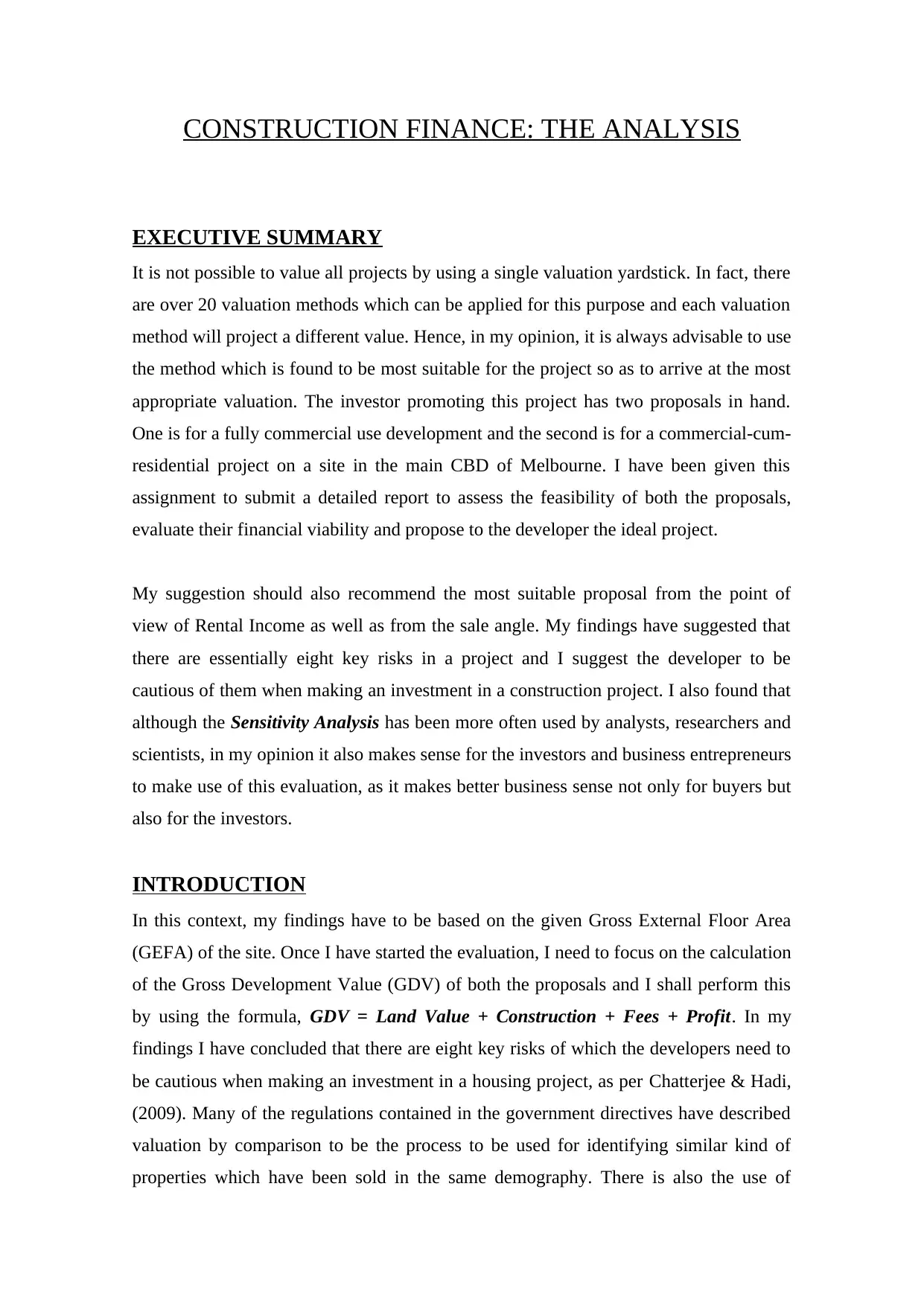
CONSTRUCTION FINANCE: THE ANALYSIS
EXECUTIVE SUMMARY
It is not possible to value all projects by using a single valuation yardstick. In fact, there
are over 20 valuation methods which can be applied for this purpose and each valuation
method will project a different value. Hence, in my opinion, it is always advisable to use
the method which is found to be most suitable for the project so as to arrive at the most
appropriate valuation. The investor promoting this project has two proposals in hand.
One is for a fully commercial use development and the second is for a commercial-cum-
residential project on a site in the main CBD of Melbourne. I have been given this
assignment to submit a detailed report to assess the feasibility of both the proposals,
evaluate their financial viability and propose to the developer the ideal project.
My suggestion should also recommend the most suitable proposal from the point of
view of Rental Income as well as from the sale angle. My findings have suggested that
there are essentially eight key risks in a project and I suggest the developer to be
cautious of them when making an investment in a construction project. I also found that
although the Sensitivity Analysis has been more often used by analysts, researchers and
scientists, in my opinion it also makes sense for the investors and business entrepreneurs
to make use of this evaluation, as it makes better business sense not only for buyers but
also for the investors.
INTRODUCTION
In this context, my findings have to be based on the given Gross External Floor Area
(GEFA) of the site. Once I have started the evaluation, I need to focus on the calculation
of the Gross Development Value (GDV) of both the proposals and I shall perform this
by using the formula, GDV = Land Value + Construction + Fees + Profit. In my
findings I have concluded that there are eight key risks of which the developers need to
be cautious when making an investment in a housing project, as per Chatterjee & Hadi,
(2009). Many of the regulations contained in the government directives have described
valuation by comparison to be the process to be used for identifying similar kind of
properties which have been sold in the same demography. There is also the use of
EXECUTIVE SUMMARY
It is not possible to value all projects by using a single valuation yardstick. In fact, there
are over 20 valuation methods which can be applied for this purpose and each valuation
method will project a different value. Hence, in my opinion, it is always advisable to use
the method which is found to be most suitable for the project so as to arrive at the most
appropriate valuation. The investor promoting this project has two proposals in hand.
One is for a fully commercial use development and the second is for a commercial-cum-
residential project on a site in the main CBD of Melbourne. I have been given this
assignment to submit a detailed report to assess the feasibility of both the proposals,
evaluate their financial viability and propose to the developer the ideal project.
My suggestion should also recommend the most suitable proposal from the point of
view of Rental Income as well as from the sale angle. My findings have suggested that
there are essentially eight key risks in a project and I suggest the developer to be
cautious of them when making an investment in a construction project. I also found that
although the Sensitivity Analysis has been more often used by analysts, researchers and
scientists, in my opinion it also makes sense for the investors and business entrepreneurs
to make use of this evaluation, as it makes better business sense not only for buyers but
also for the investors.
INTRODUCTION
In this context, my findings have to be based on the given Gross External Floor Area
(GEFA) of the site. Once I have started the evaluation, I need to focus on the calculation
of the Gross Development Value (GDV) of both the proposals and I shall perform this
by using the formula, GDV = Land Value + Construction + Fees + Profit. In my
findings I have concluded that there are eight key risks of which the developers need to
be cautious when making an investment in a housing project, as per Chatterjee & Hadi,
(2009). Many of the regulations contained in the government directives have described
valuation by comparison to be the process to be used for identifying similar kind of
properties which have been sold in the same demography. There is also the use of
Secure Best Marks with AI Grader
Need help grading? Try our AI Grader for instant feedback on your assignments.
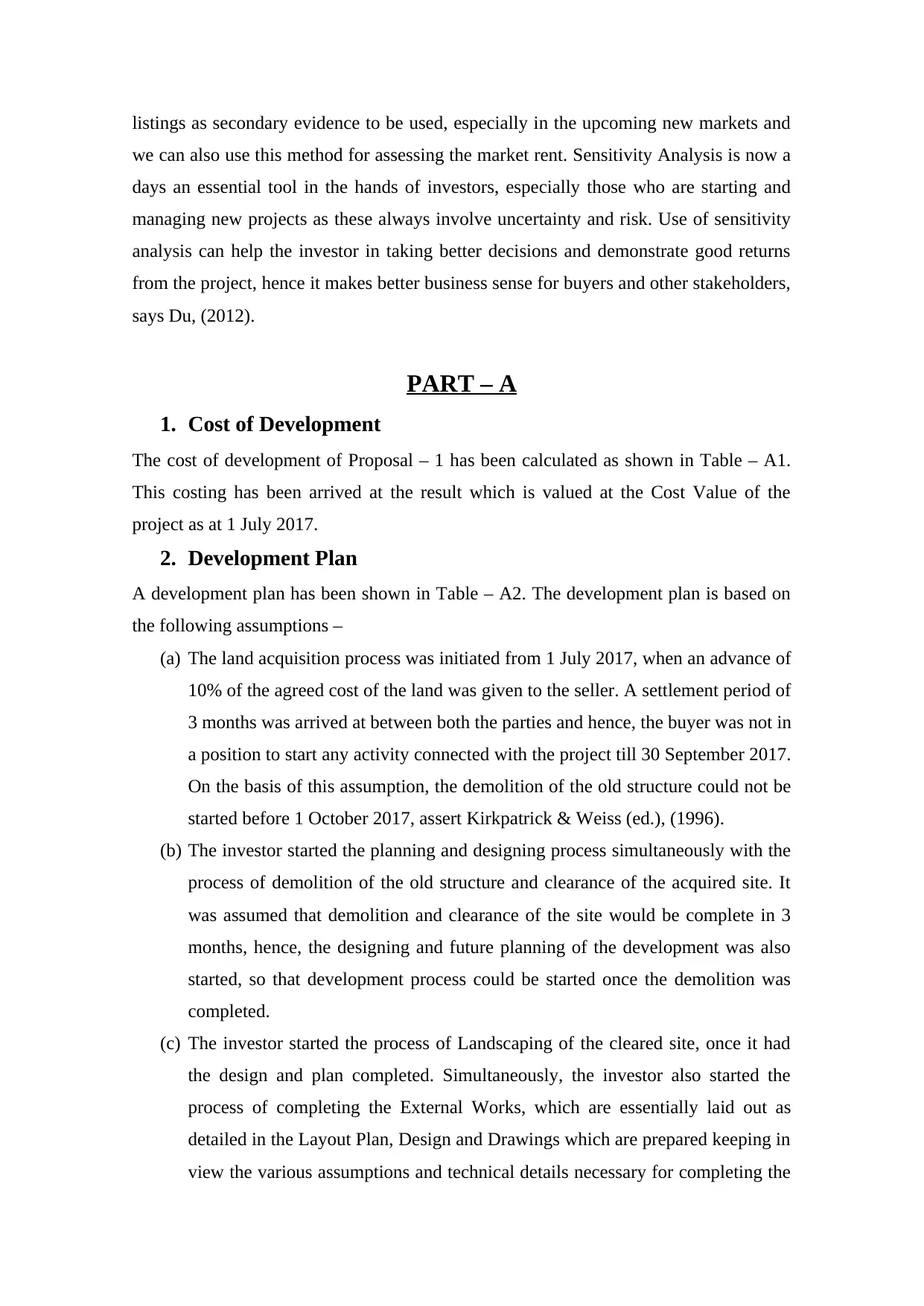
listings as secondary evidence to be used, especially in the upcoming new markets and
we can also use this method for assessing the market rent. Sensitivity Analysis is now a
days an essential tool in the hands of investors, especially those who are starting and
managing new projects as these always involve uncertainty and risk. Use of sensitivity
analysis can help the investor in taking better decisions and demonstrate good returns
from the project, hence it makes better business sense for buyers and other stakeholders,
says Du, (2012).
PART – A
1. Cost of Development
The cost of development of Proposal – 1 has been calculated as shown in Table – A1.
This costing has been arrived at the result which is valued at the Cost Value of the
project as at 1 July 2017.
2. Development Plan
A development plan has been shown in Table – A2. The development plan is based on
the following assumptions –
(a) The land acquisition process was initiated from 1 July 2017, when an advance of
10% of the agreed cost of the land was given to the seller. A settlement period of
3 months was arrived at between both the parties and hence, the buyer was not in
a position to start any activity connected with the project till 30 September 2017.
On the basis of this assumption, the demolition of the old structure could not be
started before 1 October 2017, assert Kirkpatrick & Weiss (ed.), (1996).
(b) The investor started the planning and designing process simultaneously with the
process of demolition of the old structure and clearance of the acquired site. It
was assumed that demolition and clearance of the site would be complete in 3
months, hence, the designing and future planning of the development was also
started, so that development process could be started once the demolition was
completed.
(c) The investor started the process of Landscaping of the cleared site, once it had
the design and plan completed. Simultaneously, the investor also started the
process of completing the External Works, which are essentially laid out as
detailed in the Layout Plan, Design and Drawings which are prepared keeping in
view the various assumptions and technical details necessary for completing the
we can also use this method for assessing the market rent. Sensitivity Analysis is now a
days an essential tool in the hands of investors, especially those who are starting and
managing new projects as these always involve uncertainty and risk. Use of sensitivity
analysis can help the investor in taking better decisions and demonstrate good returns
from the project, hence it makes better business sense for buyers and other stakeholders,
says Du, (2012).
PART – A
1. Cost of Development
The cost of development of Proposal – 1 has been calculated as shown in Table – A1.
This costing has been arrived at the result which is valued at the Cost Value of the
project as at 1 July 2017.
2. Development Plan
A development plan has been shown in Table – A2. The development plan is based on
the following assumptions –
(a) The land acquisition process was initiated from 1 July 2017, when an advance of
10% of the agreed cost of the land was given to the seller. A settlement period of
3 months was arrived at between both the parties and hence, the buyer was not in
a position to start any activity connected with the project till 30 September 2017.
On the basis of this assumption, the demolition of the old structure could not be
started before 1 October 2017, assert Kirkpatrick & Weiss (ed.), (1996).
(b) The investor started the planning and designing process simultaneously with the
process of demolition of the old structure and clearance of the acquired site. It
was assumed that demolition and clearance of the site would be complete in 3
months, hence, the designing and future planning of the development was also
started, so that development process could be started once the demolition was
completed.
(c) The investor started the process of Landscaping of the cleared site, once it had
the design and plan completed. Simultaneously, the investor also started the
process of completing the External Works, which are essentially laid out as
detailed in the Layout Plan, Design and Drawings which are prepared keeping in
view the various assumptions and technical details necessary for completing the
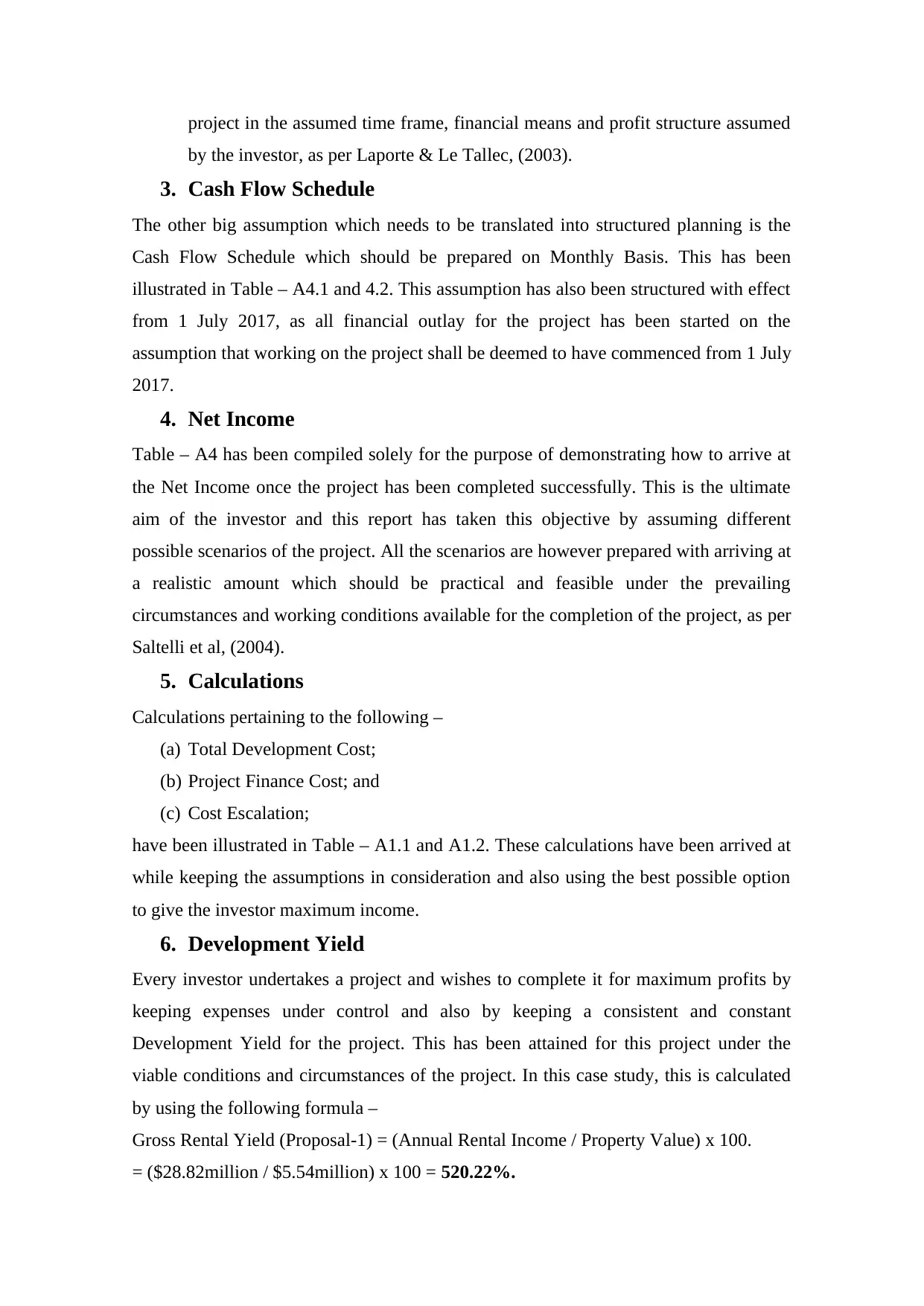
project in the assumed time frame, financial means and profit structure assumed
by the investor, as per Laporte & Le Tallec, (2003).
3. Cash Flow Schedule
The other big assumption which needs to be translated into structured planning is the
Cash Flow Schedule which should be prepared on Monthly Basis. This has been
illustrated in Table – A4.1 and 4.2. This assumption has also been structured with effect
from 1 July 2017, as all financial outlay for the project has been started on the
assumption that working on the project shall be deemed to have commenced from 1 July
2017.
4. Net Income
Table – A4 has been compiled solely for the purpose of demonstrating how to arrive at
the Net Income once the project has been completed successfully. This is the ultimate
aim of the investor and this report has taken this objective by assuming different
possible scenarios of the project. All the scenarios are however prepared with arriving at
a realistic amount which should be practical and feasible under the prevailing
circumstances and working conditions available for the completion of the project, as per
Saltelli et al, (2004).
5. Calculations
Calculations pertaining to the following –
(a) Total Development Cost;
(b) Project Finance Cost; and
(c) Cost Escalation;
have been illustrated in Table – A1.1 and A1.2. These calculations have been arrived at
while keeping the assumptions in consideration and also using the best possible option
to give the investor maximum income.
6. Development Yield
Every investor undertakes a project and wishes to complete it for maximum profits by
keeping expenses under control and also by keeping a consistent and constant
Development Yield for the project. This has been attained for this project under the
viable conditions and circumstances of the project. In this case study, this is calculated
by using the following formula –
Gross Rental Yield (Proposal-1) = (Annual Rental Income / Property Value) x 100.
= ($28.82million / $5.54million) x 100 = 520.22%.
by the investor, as per Laporte & Le Tallec, (2003).
3. Cash Flow Schedule
The other big assumption which needs to be translated into structured planning is the
Cash Flow Schedule which should be prepared on Monthly Basis. This has been
illustrated in Table – A4.1 and 4.2. This assumption has also been structured with effect
from 1 July 2017, as all financial outlay for the project has been started on the
assumption that working on the project shall be deemed to have commenced from 1 July
2017.
4. Net Income
Table – A4 has been compiled solely for the purpose of demonstrating how to arrive at
the Net Income once the project has been completed successfully. This is the ultimate
aim of the investor and this report has taken this objective by assuming different
possible scenarios of the project. All the scenarios are however prepared with arriving at
a realistic amount which should be practical and feasible under the prevailing
circumstances and working conditions available for the completion of the project, as per
Saltelli et al, (2004).
5. Calculations
Calculations pertaining to the following –
(a) Total Development Cost;
(b) Project Finance Cost; and
(c) Cost Escalation;
have been illustrated in Table – A1.1 and A1.2. These calculations have been arrived at
while keeping the assumptions in consideration and also using the best possible option
to give the investor maximum income.
6. Development Yield
Every investor undertakes a project and wishes to complete it for maximum profits by
keeping expenses under control and also by keeping a consistent and constant
Development Yield for the project. This has been attained for this project under the
viable conditions and circumstances of the project. In this case study, this is calculated
by using the following formula –
Gross Rental Yield (Proposal-1) = (Annual Rental Income / Property Value) x 100.
= ($28.82million / $5.54million) x 100 = 520.22%.
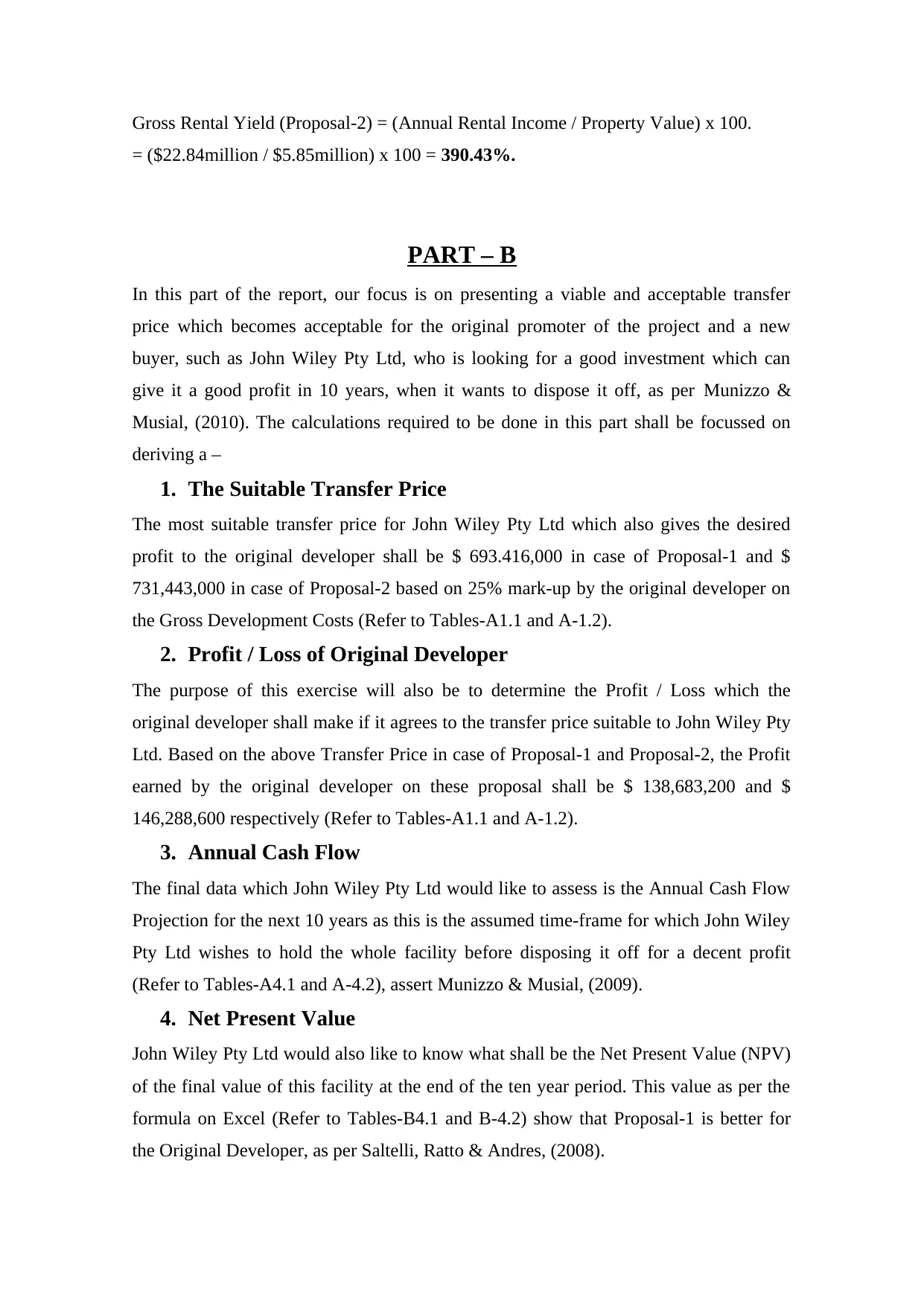
Gross Rental Yield (Proposal-2) = (Annual Rental Income / Property Value) x 100.
= ($22.84million / $5.85million) x 100 = 390.43%.
PART – B
In this part of the report, our focus is on presenting a viable and acceptable transfer
price which becomes acceptable for the original promoter of the project and a new
buyer, such as John Wiley Pty Ltd, who is looking for a good investment which can
give it a good profit in 10 years, when it wants to dispose it off, as per Munizzo &
Musial, (2010). The calculations required to be done in this part shall be focussed on
deriving a –
1. The Suitable Transfer Price
The most suitable transfer price for John Wiley Pty Ltd which also gives the desired
profit to the original developer shall be $ 693.416,000 in case of Proposal-1 and $
731,443,000 in case of Proposal-2 based on 25% mark-up by the original developer on
the Gross Development Costs (Refer to Tables-A1.1 and A-1.2).
2. Profit / Loss of Original Developer
The purpose of this exercise will also be to determine the Profit / Loss which the
original developer shall make if it agrees to the transfer price suitable to John Wiley Pty
Ltd. Based on the above Transfer Price in case of Proposal-1 and Proposal-2, the Profit
earned by the original developer on these proposal shall be $ 138,683,200 and $
146,288,600 respectively (Refer to Tables-A1.1 and A-1.2).
3. Annual Cash Flow
The final data which John Wiley Pty Ltd would like to assess is the Annual Cash Flow
Projection for the next 10 years as this is the assumed time-frame for which John Wiley
Pty Ltd wishes to hold the whole facility before disposing it off for a decent profit
(Refer to Tables-A4.1 and A-4.2), assert Munizzo & Musial, (2009).
4. Net Present Value
John Wiley Pty Ltd would also like to know what shall be the Net Present Value (NPV)
of the final value of this facility at the end of the ten year period. This value as per the
formula on Excel (Refer to Tables-B4.1 and B-4.2) show that Proposal-1 is better for
the Original Developer, as per Saltelli, Ratto & Andres, (2008).
= ($22.84million / $5.85million) x 100 = 390.43%.
PART – B
In this part of the report, our focus is on presenting a viable and acceptable transfer
price which becomes acceptable for the original promoter of the project and a new
buyer, such as John Wiley Pty Ltd, who is looking for a good investment which can
give it a good profit in 10 years, when it wants to dispose it off, as per Munizzo &
Musial, (2010). The calculations required to be done in this part shall be focussed on
deriving a –
1. The Suitable Transfer Price
The most suitable transfer price for John Wiley Pty Ltd which also gives the desired
profit to the original developer shall be $ 693.416,000 in case of Proposal-1 and $
731,443,000 in case of Proposal-2 based on 25% mark-up by the original developer on
the Gross Development Costs (Refer to Tables-A1.1 and A-1.2).
2. Profit / Loss of Original Developer
The purpose of this exercise will also be to determine the Profit / Loss which the
original developer shall make if it agrees to the transfer price suitable to John Wiley Pty
Ltd. Based on the above Transfer Price in case of Proposal-1 and Proposal-2, the Profit
earned by the original developer on these proposal shall be $ 138,683,200 and $
146,288,600 respectively (Refer to Tables-A1.1 and A-1.2).
3. Annual Cash Flow
The final data which John Wiley Pty Ltd would like to assess is the Annual Cash Flow
Projection for the next 10 years as this is the assumed time-frame for which John Wiley
Pty Ltd wishes to hold the whole facility before disposing it off for a decent profit
(Refer to Tables-A4.1 and A-4.2), assert Munizzo & Musial, (2009).
4. Net Present Value
John Wiley Pty Ltd would also like to know what shall be the Net Present Value (NPV)
of the final value of this facility at the end of the ten year period. This value as per the
formula on Excel (Refer to Tables-B4.1 and B-4.2) show that Proposal-1 is better for
the Original Developer, as per Saltelli, Ratto & Andres, (2008).
Secure Best Marks with AI Grader
Need help grading? Try our AI Grader for instant feedback on your assignments.
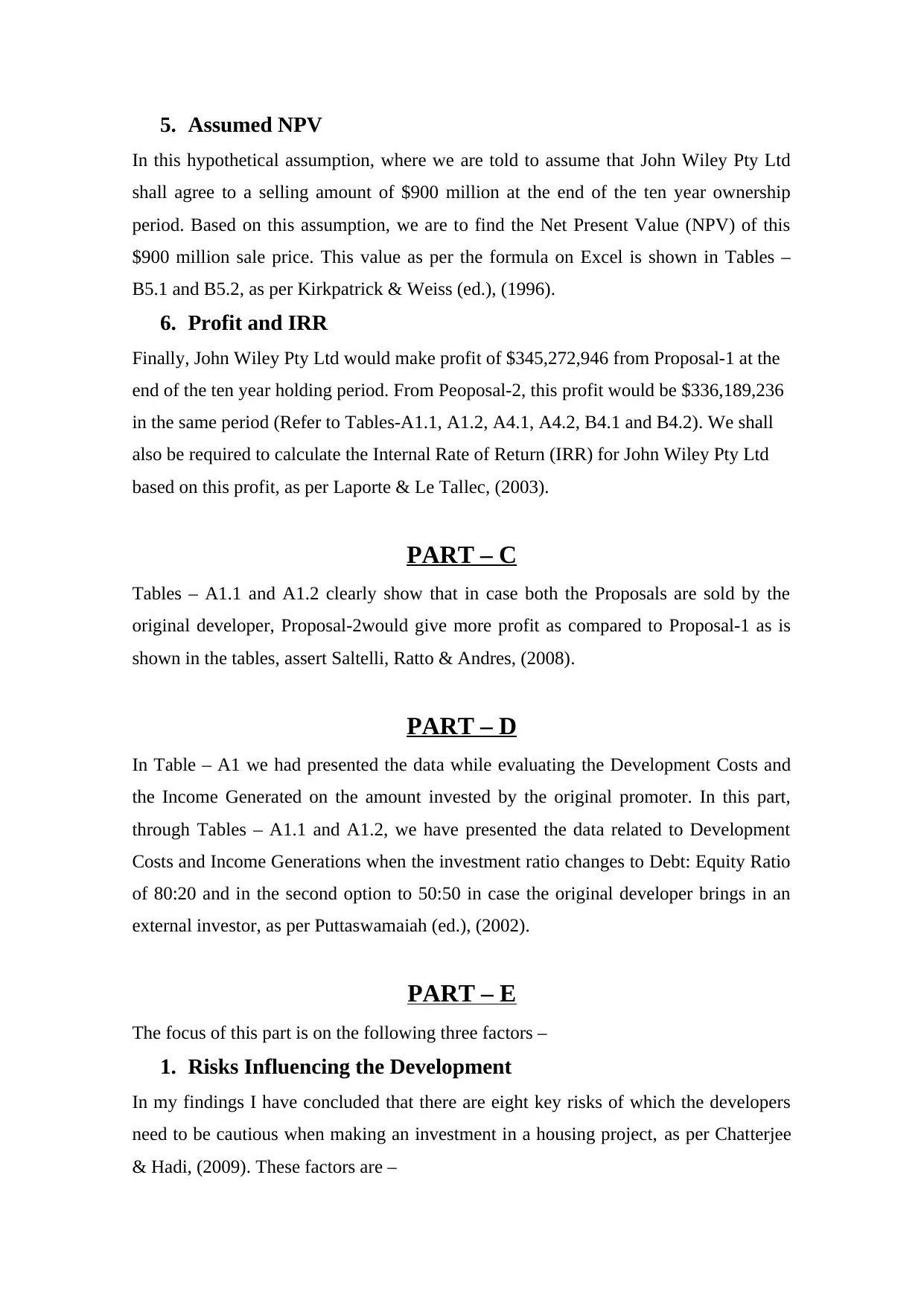
5. Assumed NPV
In this hypothetical assumption, where we are told to assume that John Wiley Pty Ltd
shall agree to a selling amount of $900 million at the end of the ten year ownership
period. Based on this assumption, we are to find the Net Present Value (NPV) of this
$900 million sale price. This value as per the formula on Excel is shown in Tables –
B5.1 and B5.2, as per Kirkpatrick & Weiss (ed.), (1996).
6. Profit and IRR
Finally, John Wiley Pty Ltd would make profit of $345,272,946 from Proposal-1 at the
end of the ten year holding period. From Peoposal-2, this profit would be $336,189,236
in the same period (Refer to Tables-A1.1, A1.2, A4.1, A4.2, B4.1 and B4.2). We shall
also be required to calculate the Internal Rate of Return (IRR) for John Wiley Pty Ltd
based on this profit, as per Laporte & Le Tallec, (2003).
PART – C
Tables – A1.1 and A1.2 clearly show that in case both the Proposals are sold by the
original developer, Proposal-2would give more profit as compared to Proposal-1 as is
shown in the tables, assert Saltelli, Ratto & Andres, (2008).
PART – D
In Table – A1 we had presented the data while evaluating the Development Costs and
the Income Generated on the amount invested by the original promoter. In this part,
through Tables – A1.1 and A1.2, we have presented the data related to Development
Costs and Income Generations when the investment ratio changes to Debt: Equity Ratio
of 80:20 and in the second option to 50:50 in case the original developer brings in an
external investor, as per Puttaswamaiah (ed.), (2002).
PART – E
The focus of this part is on the following three factors –
1. Risks Influencing the Development
In my findings I have concluded that there are eight key risks of which the developers
need to be cautious when making an investment in a housing project, as per Chatterjee
& Hadi, (2009). These factors are –
In this hypothetical assumption, where we are told to assume that John Wiley Pty Ltd
shall agree to a selling amount of $900 million at the end of the ten year ownership
period. Based on this assumption, we are to find the Net Present Value (NPV) of this
$900 million sale price. This value as per the formula on Excel is shown in Tables –
B5.1 and B5.2, as per Kirkpatrick & Weiss (ed.), (1996).
6. Profit and IRR
Finally, John Wiley Pty Ltd would make profit of $345,272,946 from Proposal-1 at the
end of the ten year holding period. From Peoposal-2, this profit would be $336,189,236
in the same period (Refer to Tables-A1.1, A1.2, A4.1, A4.2, B4.1 and B4.2). We shall
also be required to calculate the Internal Rate of Return (IRR) for John Wiley Pty Ltd
based on this profit, as per Laporte & Le Tallec, (2003).
PART – C
Tables – A1.1 and A1.2 clearly show that in case both the Proposals are sold by the
original developer, Proposal-2would give more profit as compared to Proposal-1 as is
shown in the tables, assert Saltelli, Ratto & Andres, (2008).
PART – D
In Table – A1 we had presented the data while evaluating the Development Costs and
the Income Generated on the amount invested by the original promoter. In this part,
through Tables – A1.1 and A1.2, we have presented the data related to Development
Costs and Income Generations when the investment ratio changes to Debt: Equity Ratio
of 80:20 and in the second option to 50:50 in case the original developer brings in an
external investor, as per Puttaswamaiah (ed.), (2002).
PART – E
The focus of this part is on the following three factors –
1. Risks Influencing the Development
In my findings I have concluded that there are eight key risks of which the developers
need to be cautious when making an investment in a housing project, as per Chatterjee
& Hadi, (2009). These factors are –
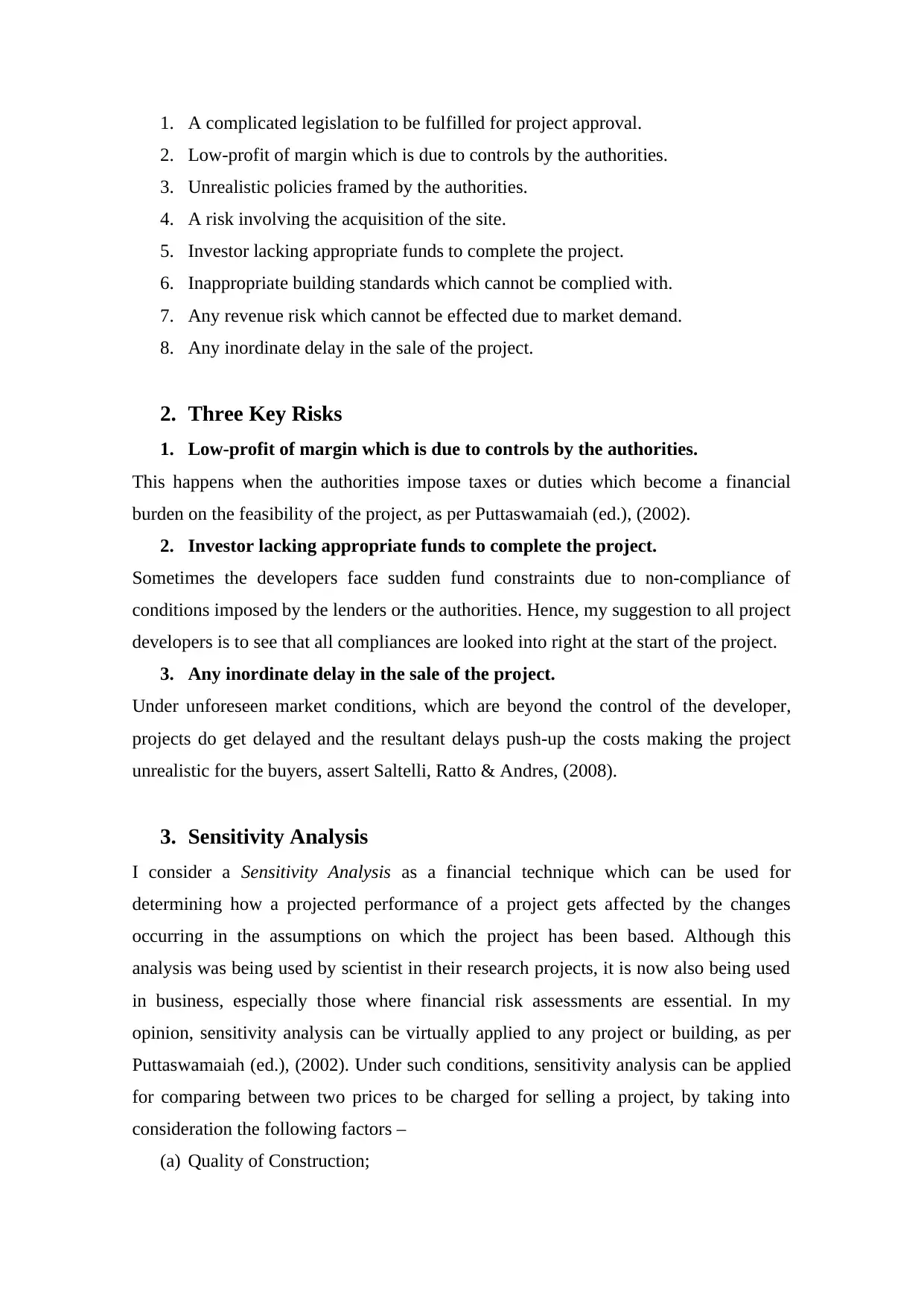
1. A complicated legislation to be fulfilled for project approval.
2. Low-profit of margin which is due to controls by the authorities.
3. Unrealistic policies framed by the authorities.
4. A risk involving the acquisition of the site.
5. Investor lacking appropriate funds to complete the project.
6. Inappropriate building standards which cannot be complied with.
7. Any revenue risk which cannot be effected due to market demand.
8. Any inordinate delay in the sale of the project.
2. Three Key Risks
1. Low-profit of margin which is due to controls by the authorities.
This happens when the authorities impose taxes or duties which become a financial
burden on the feasibility of the project, as per Puttaswamaiah (ed.), (2002).
2. Investor lacking appropriate funds to complete the project.
Sometimes the developers face sudden fund constraints due to non-compliance of
conditions imposed by the lenders or the authorities. Hence, my suggestion to all project
developers is to see that all compliances are looked into right at the start of the project.
3. Any inordinate delay in the sale of the project.
Under unforeseen market conditions, which are beyond the control of the developer,
projects do get delayed and the resultant delays push-up the costs making the project
unrealistic for the buyers, assert Saltelli, Ratto & Andres, (2008).
3. Sensitivity Analysis
I consider a Sensitivity Analysis as a financial technique which can be used for
determining how a projected performance of a project gets affected by the changes
occurring in the assumptions on which the project has been based. Although this
analysis was being used by scientist in their research projects, it is now also being used
in business, especially those where financial risk assessments are essential. In my
opinion, sensitivity analysis can be virtually applied to any project or building, as per
Puttaswamaiah (ed.), (2002). Under such conditions, sensitivity analysis can be applied
for comparing between two prices to be charged for selling a project, by taking into
consideration the following factors –
(a) Quality of Construction;
2. Low-profit of margin which is due to controls by the authorities.
3. Unrealistic policies framed by the authorities.
4. A risk involving the acquisition of the site.
5. Investor lacking appropriate funds to complete the project.
6. Inappropriate building standards which cannot be complied with.
7. Any revenue risk which cannot be effected due to market demand.
8. Any inordinate delay in the sale of the project.
2. Three Key Risks
1. Low-profit of margin which is due to controls by the authorities.
This happens when the authorities impose taxes or duties which become a financial
burden on the feasibility of the project, as per Puttaswamaiah (ed.), (2002).
2. Investor lacking appropriate funds to complete the project.
Sometimes the developers face sudden fund constraints due to non-compliance of
conditions imposed by the lenders or the authorities. Hence, my suggestion to all project
developers is to see that all compliances are looked into right at the start of the project.
3. Any inordinate delay in the sale of the project.
Under unforeseen market conditions, which are beyond the control of the developer,
projects do get delayed and the resultant delays push-up the costs making the project
unrealistic for the buyers, assert Saltelli, Ratto & Andres, (2008).
3. Sensitivity Analysis
I consider a Sensitivity Analysis as a financial technique which can be used for
determining how a projected performance of a project gets affected by the changes
occurring in the assumptions on which the project has been based. Although this
analysis was being used by scientist in their research projects, it is now also being used
in business, especially those where financial risk assessments are essential. In my
opinion, sensitivity analysis can be virtually applied to any project or building, as per
Puttaswamaiah (ed.), (2002). Under such conditions, sensitivity analysis can be applied
for comparing between two prices to be charged for selling a project, by taking into
consideration the following factors –
(a) Quality of Construction;
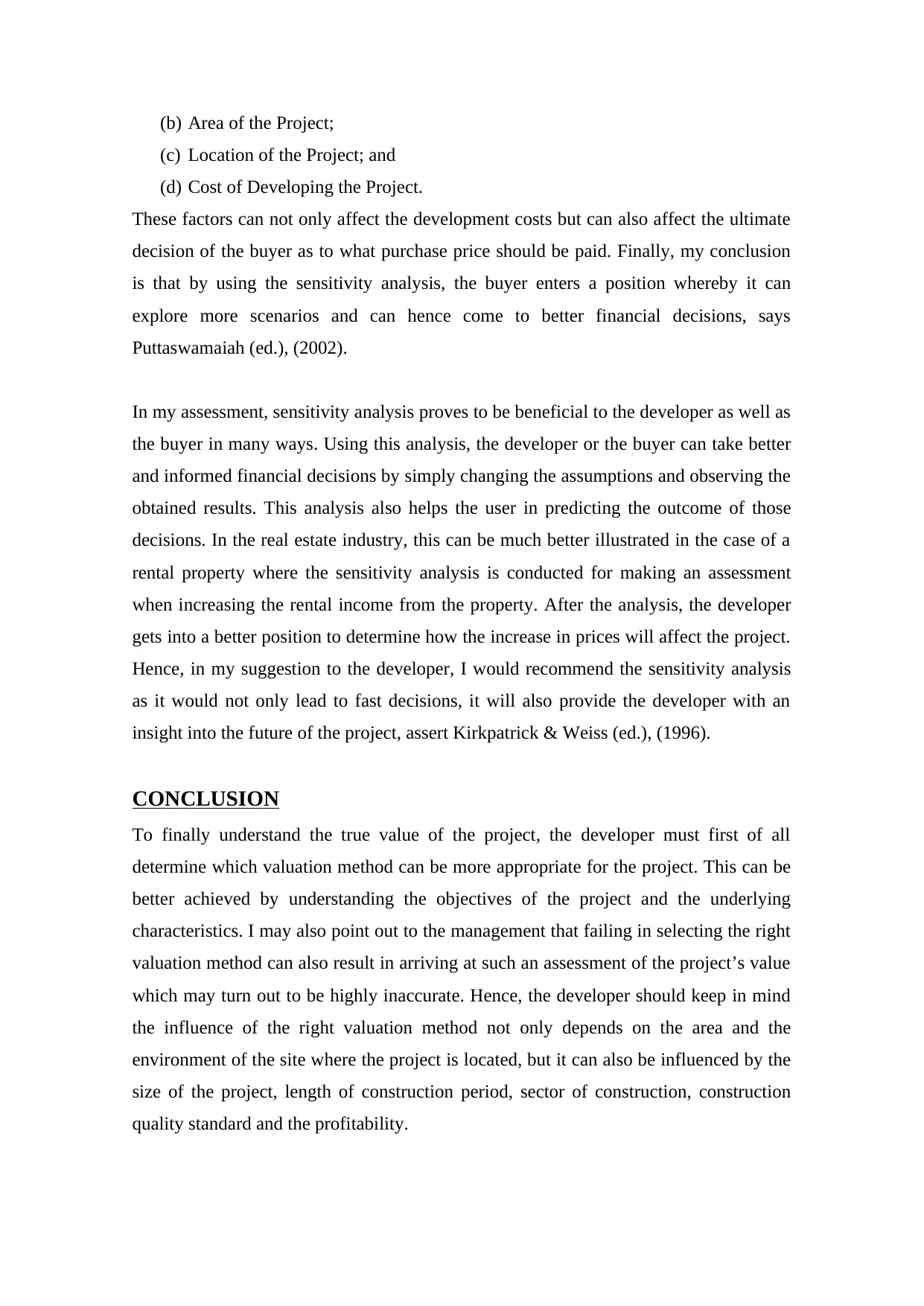
(b) Area of the Project;
(c) Location of the Project; and
(d) Cost of Developing the Project.
These factors can not only affect the development costs but can also affect the ultimate
decision of the buyer as to what purchase price should be paid. Finally, my conclusion
is that by using the sensitivity analysis, the buyer enters a position whereby it can
explore more scenarios and can hence come to better financial decisions, says
Puttaswamaiah (ed.), (2002).
In my assessment, sensitivity analysis proves to be beneficial to the developer as well as
the buyer in many ways. Using this analysis, the developer or the buyer can take better
and informed financial decisions by simply changing the assumptions and observing the
obtained results. This analysis also helps the user in predicting the outcome of those
decisions. In the real estate industry, this can be much better illustrated in the case of a
rental property where the sensitivity analysis is conducted for making an assessment
when increasing the rental income from the property. After the analysis, the developer
gets into a better position to determine how the increase in prices will affect the project.
Hence, in my suggestion to the developer, I would recommend the sensitivity analysis
as it would not only lead to fast decisions, it will also provide the developer with an
insight into the future of the project, assert Kirkpatrick & Weiss (ed.), (1996).
CONCLUSION
To finally understand the true value of the project, the developer must first of all
determine which valuation method can be more appropriate for the project. This can be
better achieved by understanding the objectives of the project and the underlying
characteristics. I may also point out to the management that failing in selecting the right
valuation method can also result in arriving at such an assessment of the project’s value
which may turn out to be highly inaccurate. Hence, the developer should keep in mind
the influence of the right valuation method not only depends on the area and the
environment of the site where the project is located, but it can also be influenced by the
size of the project, length of construction period, sector of construction, construction
quality standard and the profitability.
(c) Location of the Project; and
(d) Cost of Developing the Project.
These factors can not only affect the development costs but can also affect the ultimate
decision of the buyer as to what purchase price should be paid. Finally, my conclusion
is that by using the sensitivity analysis, the buyer enters a position whereby it can
explore more scenarios and can hence come to better financial decisions, says
Puttaswamaiah (ed.), (2002).
In my assessment, sensitivity analysis proves to be beneficial to the developer as well as
the buyer in many ways. Using this analysis, the developer or the buyer can take better
and informed financial decisions by simply changing the assumptions and observing the
obtained results. This analysis also helps the user in predicting the outcome of those
decisions. In the real estate industry, this can be much better illustrated in the case of a
rental property where the sensitivity analysis is conducted for making an assessment
when increasing the rental income from the property. After the analysis, the developer
gets into a better position to determine how the increase in prices will affect the project.
Hence, in my suggestion to the developer, I would recommend the sensitivity analysis
as it would not only lead to fast decisions, it will also provide the developer with an
insight into the future of the project, assert Kirkpatrick & Weiss (ed.), (1996).
CONCLUSION
To finally understand the true value of the project, the developer must first of all
determine which valuation method can be more appropriate for the project. This can be
better achieved by understanding the objectives of the project and the underlying
characteristics. I may also point out to the management that failing in selecting the right
valuation method can also result in arriving at such an assessment of the project’s value
which may turn out to be highly inaccurate. Hence, the developer should keep in mind
the influence of the right valuation method not only depends on the area and the
environment of the site where the project is located, but it can also be influenced by the
size of the project, length of construction period, sector of construction, construction
quality standard and the profitability.
Paraphrase This Document
Need a fresh take? Get an instant paraphrase of this document with our AI Paraphraser
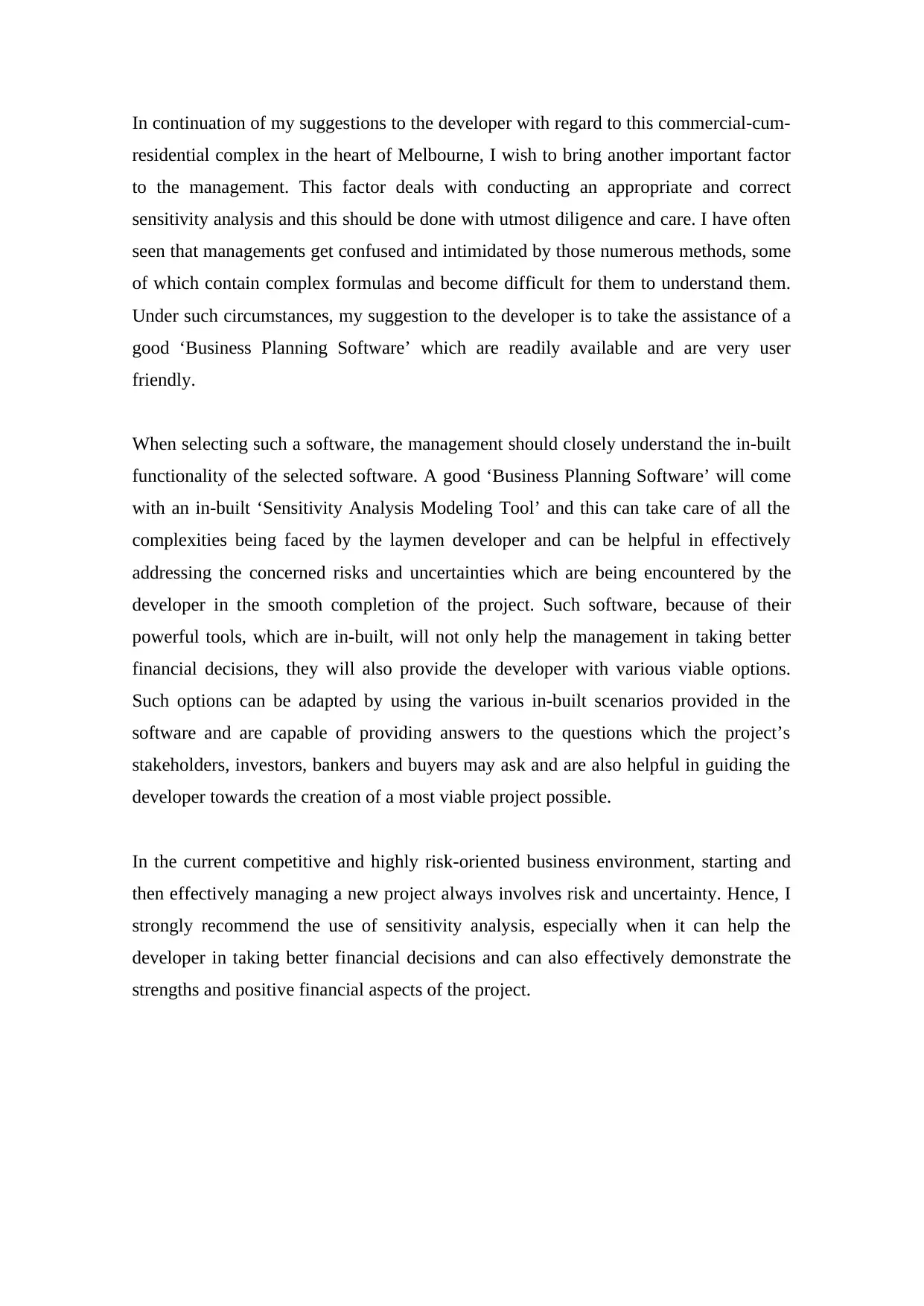
In continuation of my suggestions to the developer with regard to this commercial-cum-
residential complex in the heart of Melbourne, I wish to bring another important factor
to the management. This factor deals with conducting an appropriate and correct
sensitivity analysis and this should be done with utmost diligence and care. I have often
seen that managements get confused and intimidated by those numerous methods, some
of which contain complex formulas and become difficult for them to understand them.
Under such circumstances, my suggestion to the developer is to take the assistance of a
good ‘Business Planning Software’ which are readily available and are very user
friendly.
When selecting such a software, the management should closely understand the in-built
functionality of the selected software. A good ‘Business Planning Software’ will come
with an in-built ‘Sensitivity Analysis Modeling Tool’ and this can take care of all the
complexities being faced by the laymen developer and can be helpful in effectively
addressing the concerned risks and uncertainties which are being encountered by the
developer in the smooth completion of the project. Such software, because of their
powerful tools, which are in-built, will not only help the management in taking better
financial decisions, they will also provide the developer with various viable options.
Such options can be adapted by using the various in-built scenarios provided in the
software and are capable of providing answers to the questions which the project’s
stakeholders, investors, bankers and buyers may ask and are also helpful in guiding the
developer towards the creation of a most viable project possible.
In the current competitive and highly risk-oriented business environment, starting and
then effectively managing a new project always involves risk and uncertainty. Hence, I
strongly recommend the use of sensitivity analysis, especially when it can help the
developer in taking better financial decisions and can also effectively demonstrate the
strengths and positive financial aspects of the project.
residential complex in the heart of Melbourne, I wish to bring another important factor
to the management. This factor deals with conducting an appropriate and correct
sensitivity analysis and this should be done with utmost diligence and care. I have often
seen that managements get confused and intimidated by those numerous methods, some
of which contain complex formulas and become difficult for them to understand them.
Under such circumstances, my suggestion to the developer is to take the assistance of a
good ‘Business Planning Software’ which are readily available and are very user
friendly.
When selecting such a software, the management should closely understand the in-built
functionality of the selected software. A good ‘Business Planning Software’ will come
with an in-built ‘Sensitivity Analysis Modeling Tool’ and this can take care of all the
complexities being faced by the laymen developer and can be helpful in effectively
addressing the concerned risks and uncertainties which are being encountered by the
developer in the smooth completion of the project. Such software, because of their
powerful tools, which are in-built, will not only help the management in taking better
financial decisions, they will also provide the developer with various viable options.
Such options can be adapted by using the various in-built scenarios provided in the
software and are capable of providing answers to the questions which the project’s
stakeholders, investors, bankers and buyers may ask and are also helpful in guiding the
developer towards the creation of a most viable project possible.
In the current competitive and highly risk-oriented business environment, starting and
then effectively managing a new project always involves risk and uncertainty. Hence, I
strongly recommend the use of sensitivity analysis, especially when it can help the
developer in taking better financial decisions and can also effectively demonstrate the
strengths and positive financial aspects of the project.
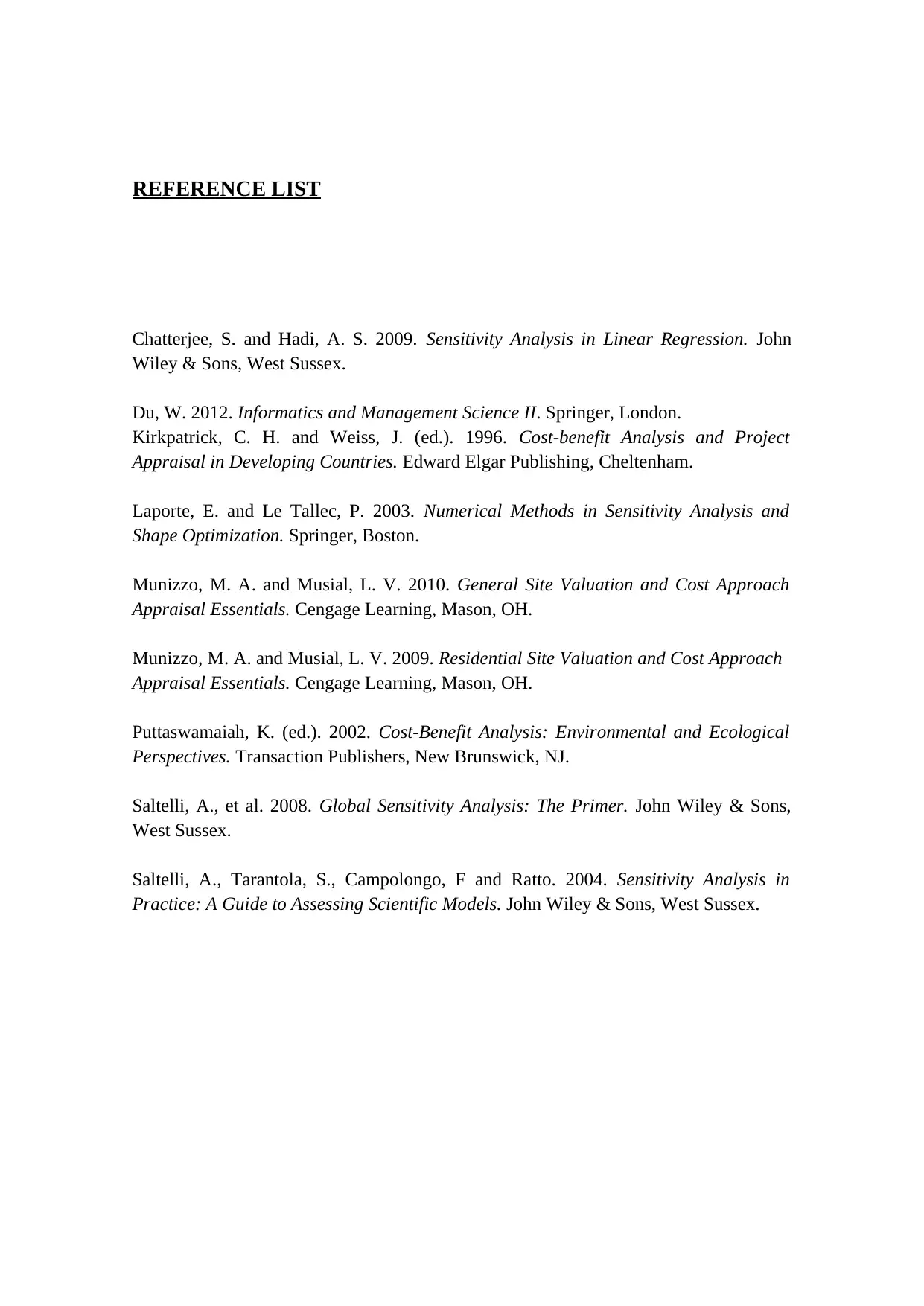
REFERENCE LIST
Chatterjee, S. and Hadi, A. S. 2009. Sensitivity Analysis in Linear Regression. John
Wiley & Sons, West Sussex.
Du, W. 2012. Informatics and Management Science II. Springer, London.
Kirkpatrick, C. H. and Weiss, J. (ed.). 1996. Cost-benefit Analysis and Project
Appraisal in Developing Countries. Edward Elgar Publishing, Cheltenham.
Laporte, E. and Le Tallec, P. 2003. Numerical Methods in Sensitivity Analysis and
Shape Optimization. Springer, Boston.
Munizzo, M. A. and Musial, L. V. 2010. General Site Valuation and Cost Approach
Appraisal Essentials. Cengage Learning, Mason, OH.
Munizzo, M. A. and Musial, L. V. 2009. Residential Site Valuation and Cost Approach
Appraisal Essentials. Cengage Learning, Mason, OH.
Puttaswamaiah, K. (ed.). 2002. Cost-Benefit Analysis: Environmental and Ecological
Perspectives. Transaction Publishers, New Brunswick, NJ.
Saltelli, A., et al. 2008. Global Sensitivity Analysis: The Primer. John Wiley & Sons,
West Sussex.
Saltelli, A., Tarantola, S., Campolongo, F and Ratto. 2004. Sensitivity Analysis in
Practice: A Guide to Assessing Scientific Models. John Wiley & Sons, West Sussex.
Chatterjee, S. and Hadi, A. S. 2009. Sensitivity Analysis in Linear Regression. John
Wiley & Sons, West Sussex.
Du, W. 2012. Informatics and Management Science II. Springer, London.
Kirkpatrick, C. H. and Weiss, J. (ed.). 1996. Cost-benefit Analysis and Project
Appraisal in Developing Countries. Edward Elgar Publishing, Cheltenham.
Laporte, E. and Le Tallec, P. 2003. Numerical Methods in Sensitivity Analysis and
Shape Optimization. Springer, Boston.
Munizzo, M. A. and Musial, L. V. 2010. General Site Valuation and Cost Approach
Appraisal Essentials. Cengage Learning, Mason, OH.
Munizzo, M. A. and Musial, L. V. 2009. Residential Site Valuation and Cost Approach
Appraisal Essentials. Cengage Learning, Mason, OH.
Puttaswamaiah, K. (ed.). 2002. Cost-Benefit Analysis: Environmental and Ecological
Perspectives. Transaction Publishers, New Brunswick, NJ.
Saltelli, A., et al. 2008. Global Sensitivity Analysis: The Primer. John Wiley & Sons,
West Sussex.
Saltelli, A., Tarantola, S., Campolongo, F and Ratto. 2004. Sensitivity Analysis in
Practice: A Guide to Assessing Scientific Models. John Wiley & Sons, West Sussex.
1 out of 9
Related Documents
Your All-in-One AI-Powered Toolkit for Academic Success.
+13062052269
info@desklib.com
Available 24*7 on WhatsApp / Email
![[object Object]](/_next/static/media/star-bottom.7253800d.svg)
Unlock your academic potential
© 2024 | Zucol Services PVT LTD | All rights reserved.





